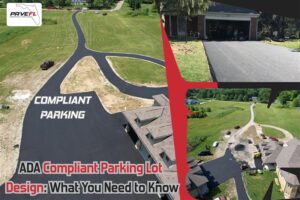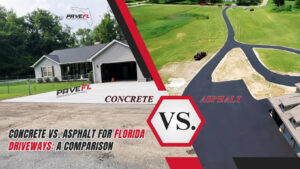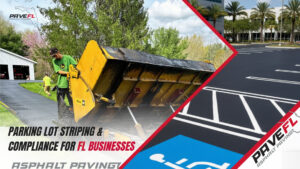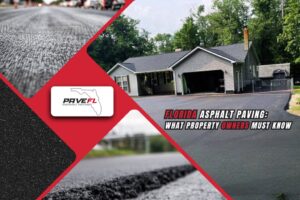
Wondering if resurfacing your driveway is a smarter option than replacing it? You’re in the right place. The key is to first check whether your driveway’s base is still strong and stable. If it is, resurfacing can save you time, money, and hassle. This guideline shows you the perfect Driveway Resurfacing Tips for Florida Homeowners.
Florida’s hot, humid weather, frequent rain, and constant exposure to sunlight make driveways wear down faster. Cracks, fading, stains, and surface erosion are common issues—even with well-built driveways. That’s where resurfacing comes in. Asphalt Resurfacing in South Florida is a cost-effective way to restore beauty, extend lifespan, and boost curb appeal without going through the heavy expense of full replacement.
For Florida homeowners, understanding the right resurfacing methods, materials, and upkeep strategies is the secret to protecting your driveway and maximizing your investment.
Why Resurfacing is Essential in Florida
Florida driveways endure intense environmental stress:
- UV and Heat Exposure – The relentless Florida sun accelerates oxidation in asphalt and causes fading, brittleness, and surface breakdown in both asphalt and concrete. Without a protective layer, surfaces quickly lose flexibility and strength.
- Heavy Rain and Humidity – Constant moisture promotes mold, mildew, and staining. Standing water seeps into cracks, leading to erosion and weakening of the sub-base.
- Tropical Storms and Hurricanes – Wind-blown debris, flooding, and heavy rainfall can crack or pit surfaces. Even if the driveway itself is intact, the underlying soil may shift, creating unevenness.
- Soil Conditions – Florida’s sandy soils and high water table contribute to settling, washouts, and undermining of driveways. Poor compaction during the initial installation accelerates these problems.
Resurfacing provides a protective new layer that seals vulnerabilities, restores appearance, and prevents minor damage from escalating. It’s not just cosmetic—it’s preventive care that saves homeowners thousands in replacement costs.
Signs Your Driveway Needs Resurfacing
Florida homeowners should watch for:
- Surface cracks: Small cracks (alligator cracking in asphalt or hairline in concrete) that are spreading.
- Color fading: Asphalt turning gray; concrete showing discoloration or staining.
- Pooling water: Standing water after rain, signaling uneven settlement.
- Rough texture: Surface erosion, pitting, or loss of aggregate.
- Mildew and stains: Persistent black or green streaks from mold, algae, or oil spills.
- Reduced curb appeal: A dull, aged driveway reduces home value and aesthetics.
If more than 25–30% of the surface is compromised, resurfacing is usually more practical than patching. Full replacement is only necessary if the structural base is failing.
Resurfacing Options for Florida Driveways
1. Asphalt Overlay
- What it is: Adding a new layer (1.5–2 inches) of hot asphalt over existing pavement.
- Benefits: Restores smoothness, covers cracks, improves durability.
- Florida considerations: Proper compaction is crucial; tropical rains during installation can compromise quality. Asphalt is cost-effective but requires ongoing sealcoating.
2. Concrete Resurfacing
- What it is: Applying a thin layer of concrete mix or resurfacer over the existing slab.
- Benefits: Extends life, renews surface color, improves strength.
- Florida considerations: Must include additives to resist moisture penetration and reduce slipperiness when wet.
3. Decorative Coatings and Sealers
- What it is: Acrylic, epoxy, or polymer-based coatings applied to concrete.
- Benefits: Adds color, slip resistance, and UV protection.
- Florida considerations: Choose UV-resistant coatings to avoid fading under the sun. Popular for homeowners wanting both function and style.
4. Paver Overlays
- What it is: Installing thin concrete or brick pavers directly over an existing surface.
- Benefits: Attractive, customizable, long-lasting.
- Florida considerations: Excellent for sandy soils, but requires proper edge restraints to prevent shifting during heavy rains.
Step-by-Step Driveway Resurfacing Process
1. Inspection & Assessment
- Evaluate cracks, drainage, and structural soundness.
- Ensure the base is stable before resurfacing.
2. Cleaning & Preparation
- Pressure wash to remove dirt, oil, and mildew.
- Fill cracks and repair damaged areas.
3. Surface Priming
- Apply bonding agents or tack coats to help the new layer adhere.
4 . Applying Resurfacing Material
- Asphalt overlay, concrete mix, coating, or paver installation.
- Ensure proper thickness and compaction.
5. Finishing
- Smooth and level surface.
- Apply decorative finishes if desired.
6. Curing & Setting
- Asphalt: allow 24–48 hours before light use.
- Concrete: 48–72 hours minimum.
- Coatings: per manufacturer’s instructions.
7. Final Sealing (Optional)
- Sealing extends lifespan by adding UV and moisture protection.
Florida-Specific Resurfacing Tactics
Florida’s climate demands precision. Resurface October–April to avoid summer heat (which prevents proper curing) and rainy-season humidity (which traps moisture). Use permeable asphalt in flood zones to allow water infiltration, reducing runoff. Incorporate geotextile fabric between layers to counter sandy soil shifting. For coastal homes, add salt-resistant aggregates to combat corrosion. Post-resurfacing, apply a reflective sealcoat within 6 months to deflect UV rays—extending lifespan by 5–7 years.
Climate-Adaptive Resurfacing Materials
MATERIAL TYPE BEST FOR FLORIDA BENEFIT COST PREMIUM Polymer-Modified Asphalt High-traffic areas Heat resistance (up to 120°F) 10–15% Porous Asphalt Flood-prone zones Reduces runoff by 70% 20–25% Warm-Mix Asphalt Eco-conscious homes Lowers emissions, cures faster in humidity 5–10% Latex-Modified Sealant Crack repair Flexibility during temperature swings 15–20%
Seasonal Considerations in Florida
- Summer (Rainy Season): Avoid scheduling resurfacing during peak storm months (June–September). Sudden downpours can wash away fresh materials.
- Winter (Dry Season): Ideal time for resurfacing due to lower rainfall and stable temperatures.
- Hurricane Preparedness: Post-storm resurfacing may be necessary if flooding undermines driveways.
- Springtime pollen and debris: Clean surfaces thoroughly before coating or resurfacing.
Maintenance Tips for Florida Driveways
- Seal Regularly – Asphalt every 2–3 years; concrete coatings every 3–5 years.
- Clean frequently – Pressure wash to prevent mildew and algae growth.
- Check Drainage – Keep gutters and driveway edges clear to avoid standing water.
- Avoid Harsh Chemicals – Choose cleaning products safe for Florida’s porous soils and eco-sensitive environment.
- Repair Small Cracks Promptly – Stop moisture intrusion before damage spreads.
- Protect Edges – Florida’s sandy soils erode quickly, so maintain strong edge restraints for pavers and borders.
Budget tips for Florida homeowners: – Get multiple quotes from licensed contractors. – Ask about warranties—especially important in storm-prone areas. – Consider lifetime costs: cheaper upfront solutions may require more frequent maintenance.
Eco-Friendly and Sustainable Resurfacing Options
- Permeable pavers: Allow water infiltration, reducing runoff and flooding.
- Cool coatings: Reflect UV rays, reducing heat absorption and keeping driveways cooler.
- Recycled asphalt or concrete: Many contractors reuse milled materials, cutting costs and environmental impact.
- Eco-sealers: Low-VOC and environmentally safe sealants protect your driveway without harming surrounding soil or plants.
Choosing the Right Contractor in Florida
A reliable contractor makes all the difference. Look for:
- Licensing & Insurance: Ensure they meet Florida’s state and county requirements.
- Experience with Florida Climate: Contractors familiar with UV, rain, and soil challenges.
- Portfolio & References: Ask for local examples of resurfacing projects.
- Quality Materials: Ensure UV-resistant sealers, moisture-resistant resurfacers, and durable aggregates are used.
- Clear Contracts & Warranties: Protects homeowners from unexpected costs.
- Local Reputation: Seek contractors who work regularly in your county and city.
Quick Decision Guide
| Scenario | Recommended Resurfacing | Benefits | Florida-Specific Tips |
|---|
| Faded asphalt driveway | Asphalt overlay + sealcoating | Restores appearance & durability | Schedule in dry season, allow full curing |
| Cracked concrete surface | Concrete resurfacer with bonding agent | Strong, smooth finish | Add anti-slip additives to resist rain slickness |
| Homeowner seeking aesthetics | Decorative coatings or pavers | Boosts curb appeal | Choose UV-resistant colors & coatings |
| Budget-conscious homeowner | Basic resurfacing (asphalt or concrete) | Affordable, extends lifespan | Maintain drainage to prevent water intrusion |
Florida Resurfacing Pitfalls to Avoid
- Timing Traps: Resurfacing in summer heat causes premature cracking. Wait for temperatures below 85°F.
- Drainage Neglect: Skipping slope adjustments (minimum 1%) creates ponds that erode bases during storms.
- Material Shortcuts: Non-polymer asphalt softens in Florida heat, leading to tire marks.
- Curing Impatience: Driving on fresh asphalt for more than 72 hours causes permanent depressions.
Final Thoughts
Asphalt Resurfacing in South Florida is one of the most effective ways to restore and protect your Florida home’s curb appeal. By choosing the right resurfacing method, working with a qualified contractor, and following proper maintenance practices, homeowners can ensure their driveway withstands Florida’s heat, rain, and humidity for years to come.
With Florida’s unique climate, it’s not just about choosing a material—it’s about planning for long-term performance. The right contractor, proper installation, and regular upkeep will keep your driveway looking fresh and functioning well, saving you money and stress in the long run.
At PaveFL, we specialize in driveway resurfacing solutions designed for Florida’s unique challenges. Our expertise ensures your resurfaced driveway will withstand our climate while enhancing your home’s beauty and value.
















